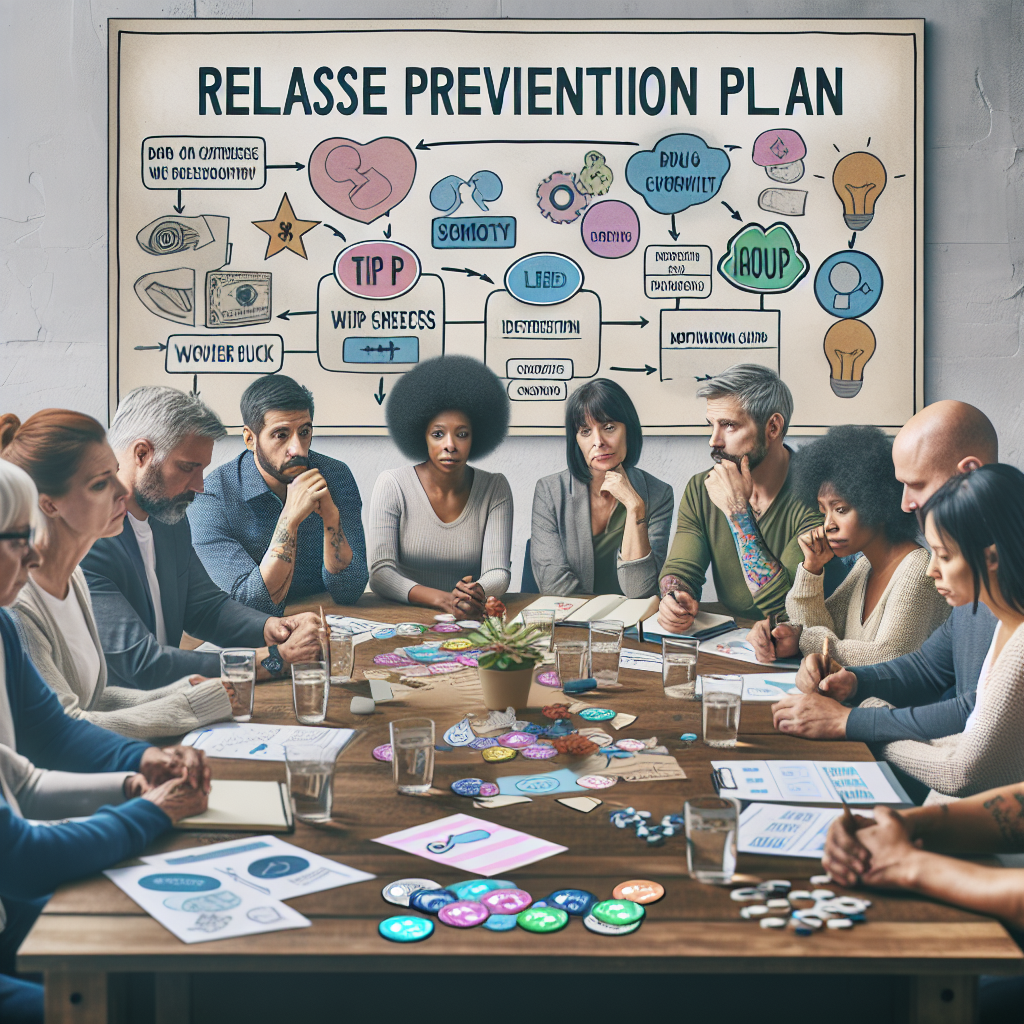-
Table of Contents

“United for Recovery: Crafting a Relapse Prevention Plan Together”
Introduction
Creating a Relapse Prevention Plan Together: Tips for Families and Addicts
Relapse prevention is a critical component of the recovery journey for individuals overcoming addiction. A well-structured relapse prevention plan not only empowers the individual in recovery but also provides a supportive framework for families to contribute effectively. This collaborative approach ensures that both the recovering addict and their loved ones are equipped with the tools and strategies necessary to navigate potential triggers and challenges. By working together, families and addicts can foster a resilient support system, enhance communication, and build a proactive plan that addresses the unique needs and circumstances of the individual. This guide offers practical tips and insights for creating a comprehensive relapse prevention plan, emphasizing the importance of mutual understanding, shared responsibility, and ongoing commitment to recovery.
Effective Communication Strategies for Families and Addicts in Relapse Prevention Planning
Effective communication is the cornerstone of any successful relapse prevention plan, especially when it involves both families and addicts working together. The journey to recovery is often fraught with challenges, and maintaining open, honest, and supportive communication can make a significant difference in preventing relapse. By fostering an environment where everyone feels heard and understood, families and addicts can collaboratively create a robust plan that addresses potential triggers and provides a safety net for difficult times.
One of the first steps in establishing effective communication is to create a safe space where all parties feel comfortable expressing their thoughts and feelings. This involves setting aside judgment and criticism, and instead, focusing on empathy and understanding. Active listening plays a crucial role here; it means truly hearing what the other person is saying without planning your response while they are speaking. This can be particularly important for addicts, who may feel vulnerable and defensive. When they sense that their family members are genuinely listening, it can encourage them to open up more freely about their struggles and fears.
In addition to active listening, it is essential to use “I” statements rather than “you” statements. For example, saying “I feel worried when you don’t come home on time” is less accusatory than “You never come home on time.” This subtle shift in language can help prevent the conversation from becoming confrontational and instead promote a more collaborative atmosphere. It allows each person to take ownership of their feelings and experiences without placing blame on others.
Another key aspect of effective communication is setting clear and realistic expectations. Families and addicts should work together to outline what each person needs and expects from the other. This might include specific actions, such as attending therapy sessions, participating in support groups, or adhering to a daily routine. By clearly defining these expectations, everyone involved can have a better understanding of their roles and responsibilities, which can help reduce misunderstandings and conflicts.
Moreover, it is important to regularly check in with each other to discuss progress and any emerging concerns. These check-ins can serve as an opportunity to celebrate successes, no matter how small, and to address any issues before they escalate. Consistent communication helps to reinforce the commitment to the relapse prevention plan and ensures that everyone remains on the same page.
In times of conflict, it is crucial to approach the situation with a problem-solving mindset rather than a confrontational one. This means focusing on finding solutions together rather than assigning blame. For instance, if an addict feels overwhelmed by certain triggers, the family can work together to identify alternative coping strategies or seek additional support. By tackling challenges as a team, families and addicts can strengthen their bond and enhance their resilience against relapse.
Lastly, it is important to recognize that effective communication is an ongoing process that requires effort and patience from all parties involved. There will be times when misunderstandings occur or emotions run high, but by committing to open and honest dialogue, families and addicts can navigate these difficulties together. Encouraging a culture of continuous improvement and mutual support can make a significant difference in the success of a relapse prevention plan.
In conclusion, effective communication strategies are vital for families and addicts working together to prevent relapse. By creating a safe space for open dialogue, using empathetic language, setting clear expectations, regularly checking in, and approaching conflicts with a problem-solving attitude, families and addicts can build a strong foundation for lasting recovery. Through these efforts, they can inspire each other to stay committed to their goals and support one another through the ups and downs of the recovery journey.
Building a Supportive Environment: Key Elements of a Successful Relapse Prevention Plan
Creating a supportive environment is crucial for the success of a relapse prevention plan, and it requires the collaborative effort of both families and individuals recovering from addiction. The journey to sobriety is often fraught with challenges, but with the right strategies and a strong support system, it is possible to navigate these obstacles effectively. One of the key elements in building a supportive environment is open communication. Families and addicts must engage in honest and empathetic conversations about their feelings, triggers, and concerns. This transparency fosters trust and understanding, which are essential for a successful relapse prevention plan.
Another important aspect is education. Families should take the time to learn about addiction, its effects, and the recovery process. This knowledge empowers them to provide informed support and recognize potential warning signs of relapse. Additionally, it helps to dispel any misconceptions or stigmas associated with addiction, creating a more compassionate and supportive atmosphere. For the individual in recovery, understanding their own addiction and the mechanisms behind it can be enlightening and motivating, reinforcing their commitment to sobriety.
Setting realistic and achievable goals is also vital. Both the recovering individual and their family should work together to establish short-term and long-term objectives. These goals should be specific, measurable, and attainable, providing a clear roadmap for the recovery journey. Celebrating small victories along the way can boost morale and reinforce positive behavior, making the path to long-term sobriety seem less daunting.
Moreover, creating a structured routine can provide stability and reduce the likelihood of relapse. A well-organized daily schedule that includes time for work, hobbies, exercise, and relaxation can help the recovering individual stay focused and productive. Families can support this by encouraging and participating in healthy activities together, such as cooking nutritious meals, engaging in physical exercise, or exploring new hobbies. This not only strengthens the bond between family members but also promotes a healthy and balanced lifestyle.
In addition to these strategies, it is essential to identify and manage triggers effectively. Triggers can be people, places, or situations that evoke memories or feelings associated with substance use. By recognizing these triggers, families and addicts can develop coping mechanisms to deal with them constructively. This might involve avoiding certain environments, practicing stress-relief techniques, or seeking professional help when needed. Having a plan in place to address triggers can significantly reduce the risk of relapse.
Furthermore, building a network of support outside the immediate family is beneficial. This can include friends, support groups, or professional counselors who understand the challenges of addiction and recovery. These external support systems provide additional layers of encouragement and accountability, making it easier for the recovering individual to stay on track. Families can facilitate this by helping to connect their loved one with these resources and encouraging their participation.
Lastly, fostering a positive and hopeful mindset is crucial. Recovery is a long-term process, and setbacks may occur. However, maintaining a positive outlook and focusing on progress rather than perfection can make a significant difference. Families should offer continuous encouragement and remind their loved one of their strengths and achievements. This positive reinforcement can inspire confidence and resilience, essential qualities for overcoming the challenges of addiction.
In conclusion, creating a supportive environment for a successful relapse prevention plan involves open communication, education, goal-setting, structured routines, trigger management, external support, and a positive mindset. By working together, families and addicts can build a strong foundation for lasting sobriety, turning the journey of recovery into a shared path of growth and healing.
Q&A
1. **Question:** What are some key components to include in a relapse prevention plan for addicts?
**Answer:** Key components include identifying triggers, developing coping strategies, establishing a support network, setting clear goals, and creating a daily routine.
2. **Question:** How can families support an addict in their relapse prevention plan?
**Answer:** Families can support by maintaining open communication, participating in therapy sessions, encouraging healthy habits, being patient and understanding, and helping to monitor and manage triggers.
Conclusion
Creating a relapse prevention plan together involves collaboration between families and addicts to identify triggers, develop coping strategies, and establish a support system. Key tips include open communication, setting realistic goals, and seeking professional guidance. By working together, families and addicts can create a comprehensive plan that promotes long-term recovery and resilience against relapse.



